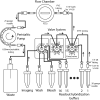RNA Imaging with Multiplexed Error-Robust Fluorescence In Situ Hybridization (MERFISH)
- PMID: 27241748
- PMCID: PMC5023431
- DOI: 10.1016/bs.mie.2016.03.020
RNA Imaging with Multiplexed Error-Robust Fluorescence In Situ Hybridization (MERFISH)
Abstract
Quantitative measurements of both the copy number and spatial distribution of large fractions of the transcriptome in single cells could revolutionize our understanding of a variety of cellular and tissue behaviors in both healthy and diseased states. Single-molecule fluorescence in situ hybridization (smFISH)-an approach where individual RNAs are labeled with fluorescent probes and imaged in their native cellular and tissue context-provides both the copy number and spatial context of RNAs but has been limited in the number of RNA species that can be measured simultaneously. Here, we describe multiplexed error-robust fluorescence in situ hybridization (MERFISH), a massively parallelized form of smFISH that can image and identify hundreds to thousands of different RNA species simultaneously with high accuracy in individual cells in their native spatial context. We provide detailed protocols on all aspects of MERFISH, including probe design, data collection, and data analysis to allow interested laboratories to perform MERFISH measurements themselves.
Keywords: In situ hybridization; RNA; Single cells; Single molecules; Single-molecule imaging; Transcriptomics.
© 2016 Elsevier Inc. All rights reserved.
Figures





References
-
- Batish M, Raj A, Tyagi S. RNA Detection and Visualization. In: Gerst JE, editor. Methods in Molecular Biology. Humana Press; Totowa, NJ: 2011.
-
- Besse F, Ephrussi A. Translational control of localized mRNAs: restricting protein synthesis in space and time. Nat. Rev. Mol. Cell Biol. 2008;9:971–980. - PubMed
Publication types
MeSH terms
Substances
Grants and funding
LinkOut - more resources
Full Text Sources
Other Literature Sources

